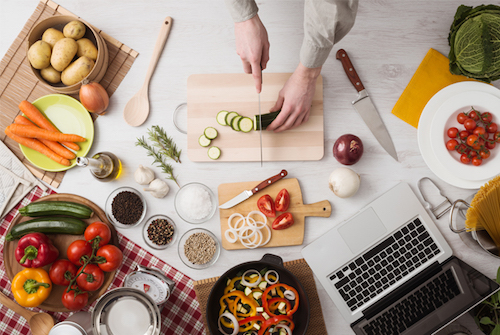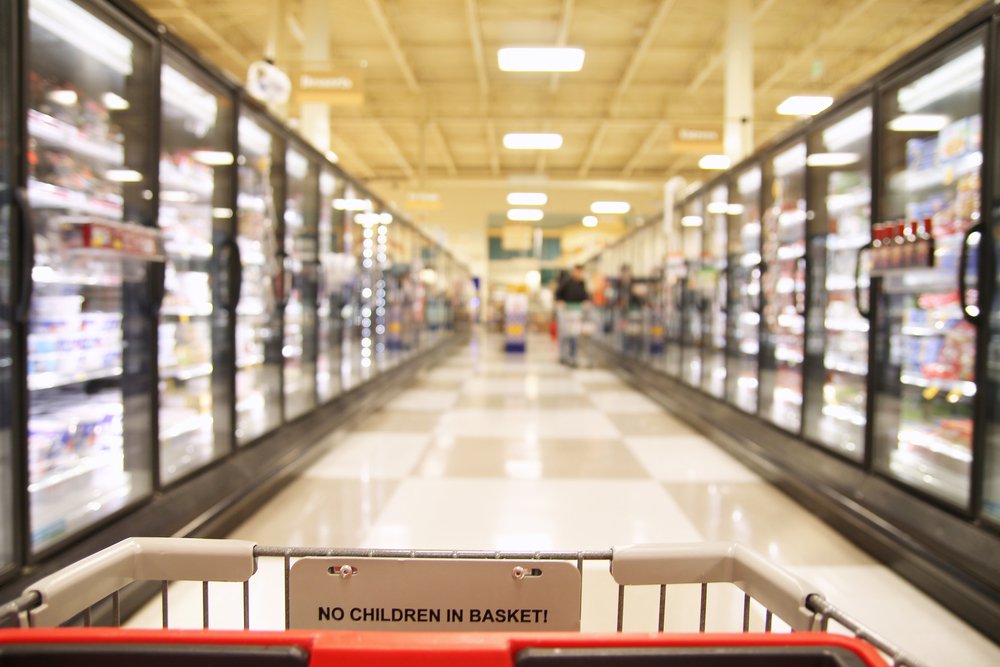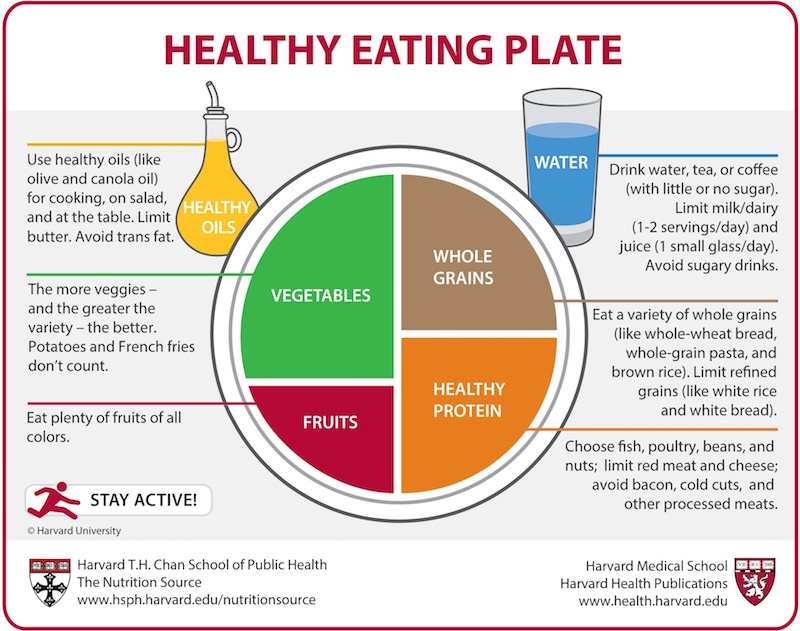Quick AND healthy?
Yes—eating healthfully doesn’t have to mean hours in the kitchen. Let me show you how!
Keep It Balanced
When preparing quick and healthy meals, start by thinking about balance. A balanced meal is made up of a variety of nutrient-dense foods, which is important because these foods provide you with the most nutrients for the fewest number of calories. A balanced meal helps you feel full and satisfied.
Follow the Healthy American Plate concept: Half of your plate, about 50%, is made up of a colorful variety of vegetables and fruits. One quarter is whole grains or complex carbs while the remaining quarter can be lean protein such as lean cuts of meat, skinless white meat poultry, fish, eggs or egg whites, soy-based foods (e.g. tofu) and beans.
Tips For a Balanced Place
- Gradually replace foods that are high in fat, sodium and added sugar with plant-based foods such as vegetables, fruits, whole grains and beans. These foods are high in nutrients, water and fiber and may help you manage your weight and stay healthy. They can help you to feel full and “fool” the body into thinking you are eating more.
- Start thinking of lean protein (e.g. fish, poultry or meat) as a side dish instead of the main course.
- Include whole grains such as oatmeal, whole-wheat bread and brown rice with your meals. Try mixing half white rice with half brown rice or half white pasta and half whole-grain pasta at first.
- You CAN change your palate. It just takes time and practice.
Making Healthy Meals Quick and Easy
With a little planning and preparation, eating healthfully at home can be a snap and save money compared to eating out. Try some or all of the following:
1. Stock Up on the Basics
A well-stocked kitchen speeds up prep time. Consider having the following items available when you are short on time or too tired to cook:
- Frozen or fresh pre-cut vegetables and fruits (without cream, sauces or added sugars)
- Pre-mixed salad greens (baby spinach, arugula, romaine)
- Canned tuna, salmon, beans (garbanzo, kidney, etc)
- Skinless chicken breast strips, lean deli meat
- Frozen skinless turkey or chicken breasts, fish fillets, vegetarian burgers
- Whole-grain foods—whole-grain breads, brown rice (instant), high-fiber cereals, whole-wheat pasta
- Low-fat, low-sodium soups, broths
- Peanut or almond butter
- Low-fat/non-fat dairy products
- Herbs, spices, tomato sauce, salsa, olive oil, vinegars, low-fat dressings
- Non-stick cooking spray
Think of items you can add to the list above and come up with 1-2 quick and healthy meals you can make using these items.
2. Grocery Shopping Lists
Using a list is especially helpful and time-saving when it comes to grocery shopping.
- Plan your meals for the week ahead and put necessary items on the list.
- Place your list in a convenient location in your kitchen so you can keep adding to it throughout the week.
- Organize your grocery list—list categories in the same order as they are in your supermarket; if you shop at more than one store, group items by where you get them.
- Pick up refrigerated/frozen foods first; consider using an insulated shopping bag with ice packs in warm weather for multiple stop trips.
- Include categories of frequently purchased items/staples on your list such as cereals, canned foods, packaged foods; bread; fresh fruits and vegetables (best to buy the ones in season); meat, poultry, fish; dairy; frozen foods; condiments, spices; beverages.
- Avoid shopping when you are hungry and if possible, shop during “off” hours and days when your supermarket is less crowded.
3. Create Leftovers
Make enough for another meal or two and save in meal-size containers or plates.
4. Time-Saving Kitchen Utensils
Make it easier to prepare healthy meals by having these items available in your kitchen:
- Non-stick pots and pans
- Vegetable steamer
- Microwave/toaster oven
- Food processor or mini-chopper
- Salad spinner
- Sharp knives
- Food storage containers (for fresh vegetables, fruits, leftovers, etc.)
- Mist spray bottle for olive oil
10 Tips to Build a Healthy Meal
Each meal is a building block in your healthy eating style. Make sure to include all the food groups throughout the day. Make fruits, vegetables, grains, dairy, and protein foods part of your daily meals and snacks. Also, limit added sugars, saturated fat, and sodium. Use the MyPlate Daily Checklist and the tips below to meet your needs throughout the day.
- Make half your plate fruits and vegetables
- Include whole grains
- Don’t forget the dairy
- Add lean protein
- Avoid extra fat
- Get creative in the kitchen
- Take control of your food
- Try new foods
- Satisfy your sweet tooth in a healthy way
- Everything you eat and drink matter.
Quick and Healthy Meal Ideas
When time is short, putting simple, quick and nutritious meals together can be easy with a few guidelines. When you are planning a meal, have at least three food groups, such as whole grains, a lean protein (e.g. meat, poultry, and fish) and a vegetable or fruit.

Also consider fitting in a low-fat dairy and a healthy fat source for balance and to keep you full and satisfied. For dinner, using a microwave to cook a potato or sweet potato is a time saver. Meats, poultry and fish also cook quickly in the microwave and can be browned in the oven. Rice, brown rice, soups or oatmeal can be cooked when you have time and keep well in the fridge for days. Think of how your plate will look!
Breakfast
Eating breakfast fuels the brain and body for your day ahead and gets your metabolism going. Mornings can be hectic. Use some of the following ideas to add variety to your breakfast:
- 1 cup whole-grain, high-fiber cereal with ½ cup low-fat milk or soy milk and a piece of fruit
- 6 oz. low-fat/non-fat plain yogurt topped with fresh or frozen berries and chopped nuts or high-fiber cereal
- Whole-grain English muffin with 1–2 tablespoons of peanut butter or almond butter and sliced banana
- Frozen whole-grain waffle or pancake toasted and topped with 6 oz. low-fat/non-fat yogurt and fresh or frozen berries
- Breakfast sandwich—2 scrambled eggs or egg whites and tomato slices between 2 slices whole-grain bread or wrapped in a whole-wheat or corn tortilla
Lunch
Busy work schedules often result in rushed lunches. Instead of grabbing fast food or take-out (which tend to be oversized), try some of these healthy lunch ideas:
- Turkey or chicken breast sandwich—3 oz. of turkey or grilled chicken breast with sliced tomato and avocado (¼) on whole-grain bread (2 slices) and piece of fruit
- 2 cups baby spinach leaves with cucumber slices, mushrooms, tomato and ½ cup chickpeas or kidney beans drizzled with olive oil and balsamic vinegar
- 1 cup lentil soup, 2 cups green salad with fresh vegetables, 2 tsp low-calorie dressing and a piece of fruit
- 3 oz. tuna packed in water, 2 cups vegetable salad tossed with 1 tsp. olive oil and balsamic vinegar in a whole-grain pita pocket
Dinner
Having to come home from work and prepare a meal can seem overwhelming but it doesn’t have to be. The following ideas add variety to your dinner:
- Broiled salmon fillet (4 oz.) with ½ cup brown rice and 1 cup spinach (steamed or lightly sautéed in olive oil and chopped garlic)
- Grilled chicken breast (3 oz.) with a medium sweet potato and 1 cup broccoli (steamed or lightly sautéed in olive oil and chopped garlic)
- Ground turkey breast burger or vegetarian burger (3-4 oz.) on a whole-grain bun with 1 cup steamed mixed vegetables
- Stir-fry firm tofu (4 oz.), 1 cup mixed vegetables, ½ cup cooked brown rice with 1 tsp. canola oil and 1 tsp low sodium soy sauce
A Word About Frozen Meals
Frozen meals are popular since they are fast, convenient, and pre-portioned—a plus for people on-the-go. They can be a healthy alternative if you choose them wisely and don’t rely on them too often. Be sure to read the food labels. Look for meals that are balanced and include whole grains, vegetables and lean protein.

Use the guidelines below for choosing a healthy frozen meal:
- 300–500 calories
- Less than 30% calories from fat (approximately 10–16 grams of total fat)
- Less than 3–4 grams saturated fat & less than 600 milligrams of sodium
- 3–5 grams of fiber & At least 10% of the RDV of vitamins and minerals
- 10–20 grams of protein – Also, be aware of the serving sizes.
Although some meals may be lower in calories, they may leave you hungry and unsatisfied. To increase the nutritional value of your meal, add a serving of steamed vegetables, side salad with low calorie dressing, piece of fruit or low-fat dairy.
With a little planning, preparation and creativity, you can enjoy healthy meals in a snap!
Need a Coach?
If you need to find someone that will hold you accountable, answer your questions, help you, and PUSH YOU for the entire duration of your workout! Luckily for you, that’s what me and my team are here for. If you don’t have a coach yet and want one, I’d love to be your coach and help you through a fitness program. I am available to help you reach your goals!

Email Me: coachchris@yourfitnesspath.com
Connect on Facebook: fb.com/coachcoburn
YouTube: https://youtu.be/coachchriscoburn
Instagram: @chris_coburn
Twitter: @yourfitnesspath




0 Comments